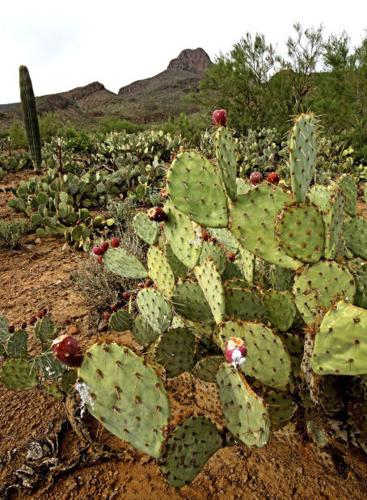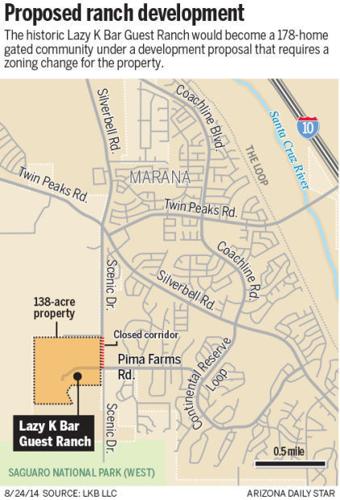A historic, environmentally sensitive dude ranch in Marana could become a 178-home gated community if a proposal to rezone and redevelop the area is approved.
The proposal for the defunct Lazy K Bar Guest Ranch — a half-mile north of Saguaro National Park West — has outraged some neighbors, who argue the development will harm a fragile watershed area and encroach upon the wildlife corridor connecting the Tucson Mountains and Tortolitas to the northeast.
Opponents say the level of density in the proposal would be a drastic departure from the 42 homes that would be allowed under the current zoning.
Even among supporters of the proposal and the compromises offered by the property’s owners, many are saddened by the prospect of the 138-acre historic ranch undergoing such a dramatic change.
“If it was up to me, I’d like it to stay the way it is. Who wouldn’t?” said Ed Stolmaker, head of the Marana Chamber of Commerce and one of the nearby residents. “But in reality, I think we have to be able to work together to try to make it work for everybody.”
Developer Mattamy Homes, Canada’s largest new home builder, would take on the project if the Marana Town Council approves the zoning change from “recreational resort” to “specific plan.”
The town’s planning commission will hold a public hearing on the rezoning request on Wednesday. Then it will make a recommendation to the town council, who makes the final decision.
The project would maintain historic features on the property, including portions of the stone house built in 1928 by the site’s original homesteaders, and would celebrate the history of the ranch, which stopped operating in 2007, the proposal says. The project would be half the density of the Ironwood Reserve subdivision to the east, said Michael Racy, a government and public relations specialist representing property owners Jim Shiner and Peter Evans.
REZONING
Shiner and Evans bought the property in 1998, when it was still part of Pima County and zoned as suburban ranch, which allows for one home per 3.3 acres. When Lazy K was annexed into Marana in 2004, it was zoned to allow for a number of uses, including residential with one home per 3.3 acres and a large resort.
Opponents say the rezoning request is out of step with Marana’s own general plan, which designates land use of the Lazy K Bar site as “rural density residential” and emphasizes maintenance of open spaces.
But one unit for every 3.3 acres is not “economically viable” for the owners, so a zoning change is necessary, Racy said. And although low-density housing is permitted under current zoning, “so is a 600-unit resort,” Racy said.
CONSERVATION PLANNING
Annexation by Marana means developers won’t have to abide by the Sonoran Desert Conservation Plan, adopted by Pima County in 2001. The City of Tucson and Oro Valley adopted parts of the plan that would limit development in critical biological areas to 80 percent open space, said Julia Fonseca, environmental planning manager in Pima County’s Office of Sustainability.
Marana chose not to adopt the conservation plan, said Ryan Mahoney, planning director for Marana. Under the Lazy K Bar development proposal, 55 percent of the site would remain open space.
Part of the reason Marana didn’t adopt the conservation plan was because it was working on its own plan, Mahoney said. But the town never formally adopted the draft version of the plan, so it isn’t legally binding. The Marana conservation plan was initially written to protect the pygmy owl in the area, but then the owl was taken off the endangered species list, he said.
Still, opponents said in a letter of protest to town council members that, “Building in fragile drainage areas and wildlife corridors is a violation of the tenets of the Marana Habitat Conservation Plan.”
Developers should be conscientious when building in fragile desert habitats, said Barbara Rose, who has lived north of the ranch on Scenic Drive for 30 years. Smart development can avoid damage to ecosystems and even help restore land like Lazy K Bar, which has been disturbed by decades of grazing cattle, she said.
“Development can change the trajectory of a landscape and watershed from going downhill to regeneration,” she said.
In response to requests from the Coalition for Desert Protection, developers altered the proposal to move some homes further east, away from the wildlife corridor, Racy said. They also pledged to avoid planting invasive species like buffelgrass.
“It’s a move in the right direction,” said Scott Stonum, acting superintendent for Saguaro National Park. “But it doesn’t address the high density of the area that’s being developed, which is still a large portion of the property and not in character with immediately adjacent parcels.”
SCENIC DRIVE
Another point of controversy is whether to re-open Scenic Drive, which runs north to south along the eastern boundary of the Lazy K Bar. It’s been partially closed for 10 years to maintain safety and quiet for residents and to allow for use by ranch animals.
Neighbors worry about increased traffic and danger to wildlife attempting to cross Scenic Drive if the Lazy K Bar proposal is approved and the road reopened. Others who live on Pima Farms Road, which dead ends at Lazy K, say Scenic Drive must be opened if the project is approved — otherwise all the extra traffic will go along Pima Farms Road.
Racy says the demand that Scenic Road be reopened came from the Town of Marana. The town told the Lazy K owners that if the developers didn’t help pay for the road to be reopened and repaved, it would not approve the rezoning, Racy said.
Conflating the two issues was a huge distraction from the question of rezoning Lazy K Bar, says Vincent Iacono, who has lived just north of Lazy K Bar for eight years. A lower-density development wouldn’t generate much traffic and the reopening of the road would be less significant, he said.
Iacono said he always knew the site would be developed one day, but he hadn’t imagined 178 homes.
“We enjoy that spot more than anything in this world,” he said. “There’s a sense of beauty that will be destroyed and forgotten.”
HISTORY
Lazy K Bar ranch began as a homestead in 1928 and reached its heyday as a guest ranch in the 1950s, Racy said. It struggled in recent years, especially as development in southern Marana made the ranch less of the remote destination visitors desired.
In the last couple of decades, the area east of the project near the I-10 corridor has filled with high-density developments, including Ironwood Reserve, Continental Ranch and Continental Reserve.
Studies have shown a decline in some wildlife in the area, including foxes, skunks and bobcats, says Stonum of Saguaro National Park. “Encroachment of high-density development is likely the cause of that,” he said.
Water scarcity has also been a major concern for residents. Neighbors say their wells have gone down since population surged in the area and they fear the impact of another 178 homes at the Lazy K site.
Stonum said the issue is not solely about this project, but about the cumulative impact of high-density housing and increased traffic, edging closer and closer to a sensitive desert ecosystem and protected land.
“We don’t want to see the park become an island in a landscape that is very densely developed,” he said.






